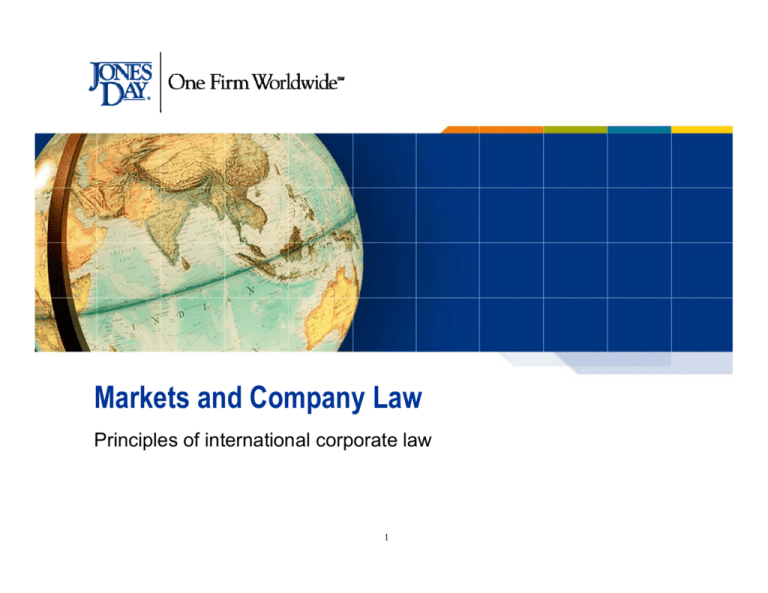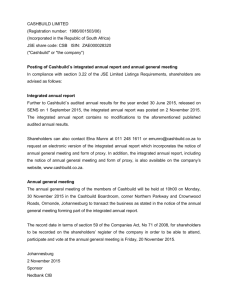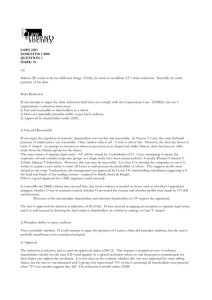Markets and Company Law
advertisement

Markets and Company p y Law Principles of international corporate law 1 Scope and nature of corporate law • Traditional definition: increasing shareholders’ value. • BUT, as with all branches of law, corporate law has a social scope. • Increasing the wealth (in the broadest of meaning) of all corporate stakeholders: shareholders, employees, suppliers and customers. • If possible, with positive externalities on third parties. 2 Sources of corporate law (1 of 2) • National legislation • International conventions • Macro-regional/federal laws and regulations (e.g. US federal laws and EU directives and regulations) • National N ti l case llaw ((common llaw vs. civil i il llaw value l off precedents) • International tribunals’ tribunals case law • Lex mercatoria, international practices 3 Sources of corporate law (2 of 2) • Examples of non corporate law impacting companies: 1. Stock exchange regulations; 2. Self-regulations (e.g. category statutes like the English City Code on mergers and acquisitions); 3. Bankruptcy and insolvency laws; 4. Employments and social security laws; 5. Criminal law (e.g. Legislative Decree 231/2011 in Italy) 4 The five fundamental characteristics of an incorporated company • • • • Corporate legal status. Liability limited to contributions. Freedom to transfer shares. Unified management acting under the guidance of an administrative d i i t ti b body. d • Ownership of the company in the hands of the equity suppliers. 5 Corporate legal personality (1 of 2) • Main feature of the legal personality of a company is its separate patrimony patrimony, also called affirmative asset partitioning. That is the capacity of the company to have its own asset separated from those of other subjects (including the investors/shareholders), and therefore not available for attachment by creditors p y other than the company’s. 6 Corporate legal personality (2 of 2) • Effects: (i) company’s creditors pre-emption rights vis-à-vis the company’s assets (which are therefore an automatic guarantee for the company company's s obligations). obligations) (ii)Impossibility for shareholders to autonomously liquidate q their p participation, p , thus p protecting g the continuation of the company’s life notwithstanding the attacks’ from the shareholders’ personal creditors. creditors 7 Liability limited to contributions • Shareholders’ limited liability has been introduced to incorporated entities only in the XIX century. • Alike legal status for the company’s creditors, shareholders limited liability creates a guarantee for the shareholders shareholders’ personal creditors creditors. The effect of this two protections allows to diminish the cost of corporate capital for both the company and the shareholders. h h ld • Main consequence of the limitation of liability: ACCESS TO FINANCING 8 Transferable shares (1 of 2) • (i) The company’s identity remains the same even if shareholders change and (ii) there is easiness in monetizing the investment. • Transfer vs. liquidation • Connection with entity shielding • All main jurisdictions include at least on type of company p y where the free transferability y of shares is the default situation. 9 Transferable shares (2 of 2) • Most jurisdictions however have forms of companies which, even if the participation can be transferred, suit “closed” companies (i.e. the shares are not intended to become widely spread) • e.g. SRL in Italy and GmbH in Germany • How is this achieved? Pre Pre-emptive emptive rights, valuation methodologies, shareholders/directors consent, restrictions by categories • By-laws vs. shareholders’ agreements • Situation changes in public companies • Can the transfer of listed shares be restricted? 10 Delegated management acting under the guidance of an administrative body (1 of 2) • Shareholders’ decisions on corporate choices feasible as long as number of the same remains relatively small and changes in participation are not frequent • Larger corporations (with fast changing shareholders) need to delegate functions to an administrative body • Impact of degree of control (dispersed shareholdings vs. tight control) 11 Delegated management acting under the guidance of an administrative body (2 of 2) • Main principles of administrative bodies: 1 Separation from operative management; 1. 2. Formal separation from the shareholders; 3. Appointed by the shareholders; 4. To be a collegiate body (important exception in closed companies with possibility of a sole administrator d i i t t lik like It Italian li SRL, SRL French F h Sàrl Sà l and d German GmbH); 5 Decisions are collegial 5. collegial, irrespective of different roles 12 Ownership of the company in the hand of the equity suppliers • Companies are “owned” by shareholders • With limitations (e.g. liquidation), cfr. definition of p law corporate • Main features of the company’s ownership: 1. The right of shareholders to control the company; and 2. The right to share the company’s profits (and losses?). losses?) • Proportional to contributions (anything else?) p cooperatives, p , foundations and no• Exceptions: profit. 13 The governance of corporations (1 of 2) • • • • • Shareholders have their rights in the company guaranteed primarily through the powers to appoint/remove directors. Corporate law regulates shareholders’ control over the company by setting the rules of the shareholders’ shareholders decision making process. The importance of voting delegation EU vs USA/UK In smaller companies corporate choices are made mainly by shareholders. As the size of a company grows, decisionmaking is delegated to managers. Choices may be heavily impacted by the regulations specific to that sector. This has a deep impact on managers’ choices (e.g. consumers protection in retail and distribution) 14 The governance of corporations (2 of 2) • • • • • • • • So called “agency issues”, what are they? Sh h ld Shareholders vs. directors. di t Minority shareholders protection. Company vs vs. other stakeholders Strategies to reduce agency issues costs Regulatory g y strategies g vs. g governance strategies g ex ante vs. ex post Regulatory agent constraints/affiliation terms • Governance appointment i t t rights/decision i ht /d i i rights/agent i ht / t incentives i ti 15 Creditors’ protection (1 of 3) Creditors • Why protecting creditors? • Creditors’ protections is also a form of guarantee for all stakeholders undertaking a relationship with a company. p y • It is common to all EU jurisdictions (with certain exceptions for the UK) to set rules on initial minimum i i corporate t capital, it l corporate t capital it l tto b be maintained during the company’s life and distribution to the shareholders. • There is discussion on the actual usefulness of such tool (e.g. often at the time of bankruptcy the corporate capital has long gone gone…). ) 16 Creditors’ protection (2 of 3) Creditors • In the USA (and in an increasing number of countries) no rules specify requirements on corporate capital. • Creditors are instead guaranteed through standards set for the actions of a number of players (managers, external accountants, controlling shareholders, privileged creditors) which have sort of fiduciary duties vis-à-vis creditors. • E.g.: UK Company C Directors Disqualification f Acts off 1986. 17 Protection of other stakeholders • Safeguards are also granted to internal and external stakeholders to the company. • Labour and employment laws, general consumer protection regulations, rights of suppliers (e.g. retention t ti off goods). d ) • Depending on the sector in which the company operates regulation may provide specific protections (e.g. consumers, employees). • Protection may be given to the market in general when the company has a large size and widespread ownership (e.g. is a listed company). • Purpose: achieving a balance that supports creation of value 18 Extraordinary transactions (1 of 2) • Decision process particularly significant when it relates to most significant steps/actions • What are extraordinary transactions? • High scale transactions if compared to the size of the company; or • A transaction the evaluation of which implies strategic views and purposes; or • A transaction which may, at least potentially, create a conflict of interest for managers (or shareholders). • examples 19 Extraordinary transactions (2 of 2) • Mergers (de-mergers) and acquisitions (private/public). (private/public) • Disposal/acquisition of assets. p increase ((or decrease). ) • Capital • Creation and placement of new shares (to shareholders or in the market). • Distributions to shareholders (through new shares or dividends). • Additional issues may arise in relation to third parties, depending on the nature of the transaction and the sector in which the company operates (e.g. employees l iin case off merger). ) 20







